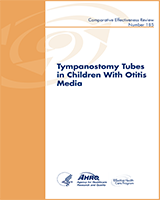NCBI Bookshelf. A service of the National Library of Medicine, National Institutes of Health.
Structured Abstract
Objectives:
The objectives for the systematic review are to synthesize information on the effectiveness of tympanostomy tubes (TT) in children with chronic otitis media with effusion and recurrent acute otitis media, summarize the frequency of adverse effects or complications associated with TT placement, synthesize information on the necessity for water precautions in children with TT, and assess the effectiveness of available treatments for otorrhea in children who have TT.
Data sources:
We conducted literature searches in MEDLINE®, the Cochrane Central Trials Registry and Cochrane Database of Systematic Reviews, Embase®, and CINAHL®. Additionally, we perused the reference lists of published relevant clinical practice guidelines and narrative and systematic reviews, and examined Scientific Information Packages from manufacturers. Citations were independently screened by two researchers.
Review methods:
Each study was extracted by one methodologist and confirmed by at least one other methodologist. Data were extracted into customized forms in the Systematic Review Data Repository (SRDR) online system. All included studies were summarized in narrative form and in summary tables. We conducted random effects meta-analyses of comparative studies that were sufficiently similar in population, interventions, and outcomes, and network meta-analyses to compare treatment alternatives across studies. Specific methods and metrics (summary measures) meta-analyzed were chosen based on available reported study data. The PROSPERO protocol registration number is CRD42015029623.
Results and conclusions:
The literature search yielded 13,334 citations, of which 172 articles are included in the report. Overall, the evidence suggests that TT placed in children with persistent middle-ear effusion improve hearing at 1 to 3 months compared to watchful waiting, but there is no benefit at 12 to 24 months. TT did not consistently improve language, cognition, behavior, or quality of life. However, evidence is sparse, limiting definitive conclusions, and is applicable only to otherwise healthy children. The current evidence base provides little guidance for the treatment of children with cleft palate or Down syndrome. Children with recurrent acute otitis media may have fewer episodes after TT placement, but the evidence base is limited and there is insufficient evidence to assess the impact on quality of life. The benefits of TT placement must be weighed against a variety of adverse events. There is no compelling evidence for children with TT to avoid swimming or bathing, or use earplugs or bathing caps. Should otorrhea develop, the evidence supports topical treatment rather than oral antibiotics or watchful waiting.
Contents
- Preface
- Key Informants
- Technical Expert Panel
- Peer Reviewers
- Executive Summary
- Introduction
- Methods
- Results
- Discussion
- References
- Appendix A. Literature Search
- Appendix B. Excluded Studies
- Appendix C. Study Design
- Appendix D. Arm Details
- Appendix E. Baseline Characteristics
- Appendix F. Risk of Bias
- Appendix G. Patient-Centered and Quality of Life Outcomes
- Appendix H. Harms
- Appendix I. Network Meta-Analysis Model, Inconsistency Analysis Results, and Illustrative Trace and Posterior Density Plots
Suggested citation:
Steel D, Adam GP, Di M, Halladay C, Pan I, Coppersmith N, Balk EM, Trikalinos TA. Tympanostomy Tubes in Children With Otitis Media. Comparative Effectiveness Review No. 185. (Prepared by the Brown Evidence-based Practice Center under Contract No. 290-2015-00002-I.) AHRQ Publication No. 17-EHC003-EF. Rockville, MD: Agency for Healthcare Research and Quality; May 2017. www.effectivehealthcare.ahrq.gov/reports/final.cfm. doi: https://doi.org/10.23970/AHRQEPCCER185.
This report is based on research conducted by the Brown Evidence-based Practice Center (EPC) under contract to the Agency for Healthcare Research and Quality (AHRQ), Rockville, MD (Contract No. 290-2015-00002-I). The findings and conclusions in this document are those of the authors, who are responsible for its contents; the findings and conclusions do not necessarily represent the views of AHRQ. Therefore, no statement in this report should be construed as an official position of AHRQ or of the U.S. Department of Health and Human Services.
None of the investigators have any affiliations or financial involvement that conflicts with the material presented in this report.
The information in this report is intended to help health care decisionmakers—patients and clinicians, health system leaders, and policymakers, among others—make well-informed decisions and thereby improve the quality of health care services. This report is not intended to be a substitute for the application of clinical judgment. Anyone who makes decisions concerning the provision of clinical care should consider this report in the same way as any medical reference and in conjunction with all other pertinent information, i.e., in the context of available resources and circumstances presented by individual patients.
AHRQ or U.S. Department of Health and Human Services endorsement of any derivative products that may be developed from this report, such as clinical practice guidelines, other quality enhancement tools, or reimbursement or coverage policies, may not be stated or implied.
This report may periodically be assessed for the currency of conclusions. If an assessment is done, the resulting surveillance report describing the methodology and findings will be found on the Effective Health Care Program Web site at www.effectivehealthcare.ahrq.gov. Search on the title of the report.
- 1
5600 Fishers Lane, Rockville, MD 20857; www
.ahrq.gov
- NLM CatalogRelated NLM Catalog Entries
- Tympanostomy Tubes in Children With Otitis MediaTympanostomy Tubes in Children With Otitis Media
Your browsing activity is empty.
Activity recording is turned off.
See more...
